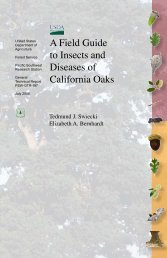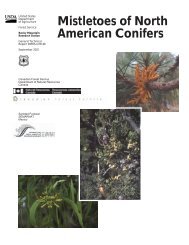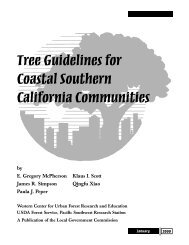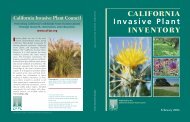Guideline Specifications for Nursery Tree Quality - Our City Forest
Guideline Specifications for Nursery Tree Quality - Our City Forest
Guideline Specifications for Nursery Tree Quality - Our City Forest
You also want an ePaper? Increase the reach of your titles
YUMPU automatically turns print PDFs into web optimized ePapers that Google loves.
<strong>Guideline</strong> <strong>Specifications</strong> <strong>for</strong> <strong>Nursery</strong> <strong>Tree</strong> <strong>Quality</strong><br />
Selecting <strong>Quality</strong> <strong>Nursery</strong> Stock<br />
A committee comprised of municipal arborists, urban <strong>for</strong>esters, nurserymen, U.C. Cooperative<br />
Extension horticultural advisors, landscape architects, non–profit tree groups, horticultural<br />
consultants, etc., developed the attached specifications to ensure high quality landscape<br />
trees. After more than a year of work, they succeeded in drafting a document entitled Specification<br />
<strong>Guideline</strong>s <strong>for</strong> Container–grown <strong>Tree</strong>s <strong>for</strong> Cali<strong>for</strong>nia. This document will be published<br />
and the guidelines promoted throughout the nursery and landscape industry. Its intent is to<br />
help landscape professionals develop their own comprehensive and detailed specifications to<br />
ensure that they obtain high quality container–grown nursery trees. The document is also<br />
intended to help nursery professionals in their ef<strong>for</strong>ts to improve the quality of trees grown in<br />
Cali<strong>for</strong>nia. These specifications can be modified <strong>for</strong> specific simulations.<br />
The following people worked on the <strong>Guideline</strong> <strong>Specifications</strong> <strong>for</strong> <strong>Nursery</strong> <strong>Tree</strong> <strong>Quality</strong>:<br />
David Burger<br />
Barrie Coate<br />
Larry Costello<br />
Robert Crudup<br />
Jim Geiger<br />
Bruce Hagen<br />
Richard Harris<br />
Brian Kempf<br />
Jerry Koch<br />
Bob Ludekens<br />
Greg McPherson<br />
Martha Ozonoff<br />
Ed Perry<br />
Markio Roberts<br />
UC Davis, Department of Environmental Horticulture, Davis<br />
Consulting Arborist, Los Gatos<br />
UC Cooperative Extension, Half Moon Bay<br />
Valley Crest <strong>Tree</strong> Company, Sunol<br />
Center <strong>for</strong> Urban <strong>Forest</strong> Research UC Davis, Davis<br />
Cali<strong>for</strong>nia Dept. of <strong>Forest</strong>ry & Fire Protection, Santa Rosa<br />
UC Davis Department of Environmental Horticulture, Davis<br />
Urban <strong>Tree</strong> Foundation, Visalia<br />
<strong>City</strong> of Berkeley Division of Urban <strong>Forest</strong>ry, Berkeley<br />
L. E. Cooke Company, Visalia<br />
Center <strong>for</strong> Urban <strong>Forest</strong> Research, UC Davis, Davis<br />
Cali<strong>for</strong>nia ReLeaf, Sacramento<br />
UC Cooperative Extension, Stanislaus County<br />
Caltrans, LDA Maintenance Division, Oakland<br />
Illustrations:<br />
Front page, c) temporary branches C. Trunk Taper Illustration by Edward F. Gilman, Professor, Environmental Horticulture Department,<br />
IFAS, University of Florida.<br />
All other Illustrations adapted from Integrated Management of Landscape <strong>Tree</strong>s, Shrubs and Vines, Fourth Edition, 2003, Harris, Clark,<br />
Matheny<br />
Photos: Brian Kempf<br />
For more in<strong>for</strong>mation contact Brian Kempf 559–713–0631 or brian@urbantree.org
<strong>Guideline</strong> <strong>Specifications</strong> <strong>for</strong> <strong>Nursery</strong> <strong>Tree</strong> <strong>Quality</strong><br />
I. PROPER IDENTIFICATION<br />
All trees shall be true to name as ordered or shown on the planting<br />
plans and shall be labeled individually or in groups by species and<br />
cultivar (where appropriate).<br />
II. COMPLIANCE<br />
All trees shall comply with federal and state laws and regulations<br />
requiring inspection <strong>for</strong> plant disease, pests and weeds. Inspection<br />
certificates required by law shall accompany each shipment of plants.<br />
Clearance from the County Agricultural Commissioner, if required,<br />
shall be obtained be<strong>for</strong>e planting trees originating outside the county<br />
in which they are to be planted. Even though trees may con<strong>for</strong>m to<br />
county, state, and federal laws, the buyer may impose additional<br />
requirements.<br />
Illustration by Edward F. Gilman, Professor,<br />
Environmental Horticulture Department, IFAS,<br />
University of Florida.<br />
III. TREE CHARACTERISTICS AT THE TIME OF SALE OR DELIVERY<br />
A. TREE HEALTH<br />
As typical <strong>for</strong> the species/cultivar, trees shall be healthy and vigorous, as indicated by an<br />
inspection <strong>for</strong> the following:<br />
1. <strong>Tree</strong>s shall be relatively free of pests (insects, pathogens, nematodes or other injurious<br />
organisms).<br />
2. An inspection of the crown, trunk, and roots shall find the following characteristics:<br />
a. Crown Form: The <strong>for</strong>m or shape of the crown is typical <strong>for</strong> a young specimen of the species/cultivar.<br />
The crown is not significantly de<strong>for</strong>med by wind, pruning practices, pests or<br />
other factors.<br />
b. Leaves: The size, color and appearance of leaves are typical <strong>for</strong> the time of year and stage<br />
of growth of the species/cultivar. Leaves are not stunted, misshapen, tattered, discolored<br />
(chlorotic or necrotic) or otherwise atypical.<br />
c. Branches: Shoot growth (length and diameter) throughout the crown is typical <strong>for</strong> the age/<br />
size of the species/cultivar. <strong>Tree</strong>s do not have dead, diseased, broken, distorted or other<br />
serious branch injuries.<br />
d. Trunk: The tree trunk should be fairly straight, vertical and free of wounds (except properly–made<br />
pruning cuts), sunburned areas, conks (fungal fruiting bodies), wood cracks,<br />
bleeding areas, signs of boring insects, galls, cankers/lesions and girdling ties.<br />
e. <strong>Tree</strong> height and trunk diameter are typical <strong>for</strong> the age, species/cultivar and container size.<br />
f. Roots: The root system is free of injury from biotic (insects, pathogens, etc.) and abiotic<br />
agents (herbicide toxicity, salt injury, excess irrigation, etc.). Root distribution is uni<strong>for</strong>m<br />
throughout the soil mix or growth media and growth is typical <strong>for</strong> the species/cultivar.
B. CROWN<br />
1. Central Leader: <strong>Tree</strong>s shall have a single, relatively straight central leader and tapered<br />
trunk, free of codominant stems and vigorous, upright branches that compete with the central<br />
leader. If the original leader has been headed, a new leader at least ½ (one–half) the diameter<br />
of the original leader shall be present.<br />
Maintaining a single, centeral leader is preferable.<br />
Heading and retaining a leader is acceptable.<br />
Heading without retaining a leader is unacceptable.
2. Main Branches (scaffolds): Branches should be distributed radially around and vertically<br />
along the trunk, <strong>for</strong>ming a generally symmetrical crown typical <strong>for</strong> the species.<br />
a) Main branches, <strong>for</strong> the most part, shall be well spaced.<br />
preferable unacceptable preferable unacceptable<br />
b) Branch diameter shall be no greater than 2/3 (two thirds) the diameter of the trunk,<br />
measured 1" (one inch) above the branch.<br />
preferable unacceptable<br />
preferable unacceptable<br />
c) The attachment of scaffold branches shall be free of included bark.<br />
preferable unacceptable preferable unacceptable
3. Temporary branches: Temporary branches should be present along the lower trunk,<br />
particularly <strong>for</strong> trees less than 1–1/2" (one and one–half inches) in trunk diameter. They<br />
should be no greater than 3/8" (three–eighths inch) in diameter. Heading of temporary<br />
branches is often necessary to limit their growth.<br />
C. TRUNK<br />
Good<br />
Not as Good<br />
1. Trunk diameter and taper shall be sufficient so that the tree will remain vertical without<br />
the support of a nursery stake.<br />
2. The trunk shall be free of wounds (except properly–made pruning cuts), sunburned areas,<br />
conks (fungal fruiting–bodies), wood cracks, bleeding areas, signs of boring insects, galls,<br />
cankers and/or lesions.<br />
3. Trunk diameter at 6" (six inches) above the soil surface shall be within the diameter range<br />
shown <strong>for</strong> each container size below:<br />
Container Size<br />
Trunk Diameter (inches)<br />
# 5 (gallon) ....................... 0.5" to 0.75"<br />
# 15 (gallon) .................... 0.75" to 1.5"<br />
24 inch box ....................... 1.5" to 2.5"
D. ROOTS<br />
1. The trunk, root collar (root crown) and large roots shall be free of circling and/or kinked<br />
roots. Soil removal near the root collar may be necessary to inspect <strong>for</strong> circling and/or kinked<br />
roots.<br />
preferable<br />
unacceptable<br />
2. The tree shall be well rooted in the soil mix. When the container is removed, the rootball<br />
shall remain intact. When the trunk is carefully lifted both the trunk and root system shall move<br />
as one.<br />
preferable<br />
unacceptable<br />
3. The upper–most roots or root collar shall be within 1" (one inch) above or below<br />
the soil surface.<br />
preferable<br />
unacceptable
4. The rootball periphery should be free of large circling and bottom–matted roots. The<br />
acceptable diameter of circling peripheral roots depends on species and size of rootball. The<br />
maximum acceptable size should be indicated <strong>for</strong> the species (if necessary).<br />
preferable<br />
unacceptable<br />
E. MOISTURE STATUS<br />
At time of inspection and delivery, the rootball shall be moist throughout. The crown shall<br />
show no signs of moisture stress as indicated by wilted, shriveled or dead leaves or branch<br />
dieback. The roots shall show no signs of excess soil moisture conditions as indicated by poor<br />
root growth, root discoloration, distortion, death or foul odor.<br />
V. INSPECTION<br />
The buyer reserves the right to reject trees that do not meet specifications as set <strong>for</strong>th<br />
in these guidelines or as specified by the buyer. If a particular defect or substandard<br />
element or characteristic can be easily corrected, appropriate remedies shall be required.<br />
If destructive inspection of a rootball(s) is to be done, the buyer and seller<br />
should have a prior agreement as to the time and place of inspection, minimum number<br />
of trees or percentage of a species or cultivar to be inspected and financial responsibility<br />
<strong>for</strong> the inspected trees.<br />
DELIVERY<br />
The buyer should stipulate how many days prior to delivery that notification is needed.
GLOSSARY:<br />
Codominant – Two or more vigorous and upright branches of relatively equal<br />
size that originate from a common point, usually where the leader has been lost<br />
or removed.<br />
Crown – The aboveground part of the tree including the trunk.<br />
Cultivar – A named plant selection from which identical or nearly identical<br />
plants can be produced, usually by vegetative propagation or cloning.<br />
Girdling root – A root that partially or entirely encircles the trunk and/or<br />
buttress roots, which could restrict growth and downward movement of photosynthate<br />
and/or water and nutrients up.<br />
Included bark – Bark embedded within the crotch between a branch and the<br />
trunk or between two or more stems that prevents the <strong>for</strong>mation of a normal<br />
branch bark ridge. This often occurs in branches with narrow-angled attachments<br />
or branches resulting from the loss of the leader. Such attachments are<br />
weakly attached and subject to splitting out.<br />
Kinked root – A primary root(s), which is sharply bent, causing a restriction<br />
to water, nutrient, and photosynthate movement. Kinked roots may compromise<br />
the structural stability of root systems.<br />
Leader – The dominant stem which usually develops into the main trunk.<br />
Photosynthate – Pertains to sugar and other carbohydrates that are produced<br />
by the foliage during photosynthesis, an energy trapping process.<br />
Root collar – The flared area at the base of a tree where the roots and trunk<br />
merge. Also referred to as the "root crown" or "root flare".<br />
Shall – Used to denote a practice that is mandatory.<br />
Should – Used to denote a practice that is recommended.<br />
Scaffold branches – Large, main branches that <strong>for</strong>m the main structure of the<br />
tree.<br />
Temporary branch – A small branch that is retained temporarily along the<br />
lower trunk of young trees. Temporary branches provide photosynthate to<br />
increase trunk caliper and taper and help protect it from sunburn damage and<br />
mechanical injury. Such branches should be kept small and gradually removed<br />
as the trunk develops.<br />
Trunk – The main stem or axis of a tree that is supported and nourished by the roots<br />
and to which branches are attached.







